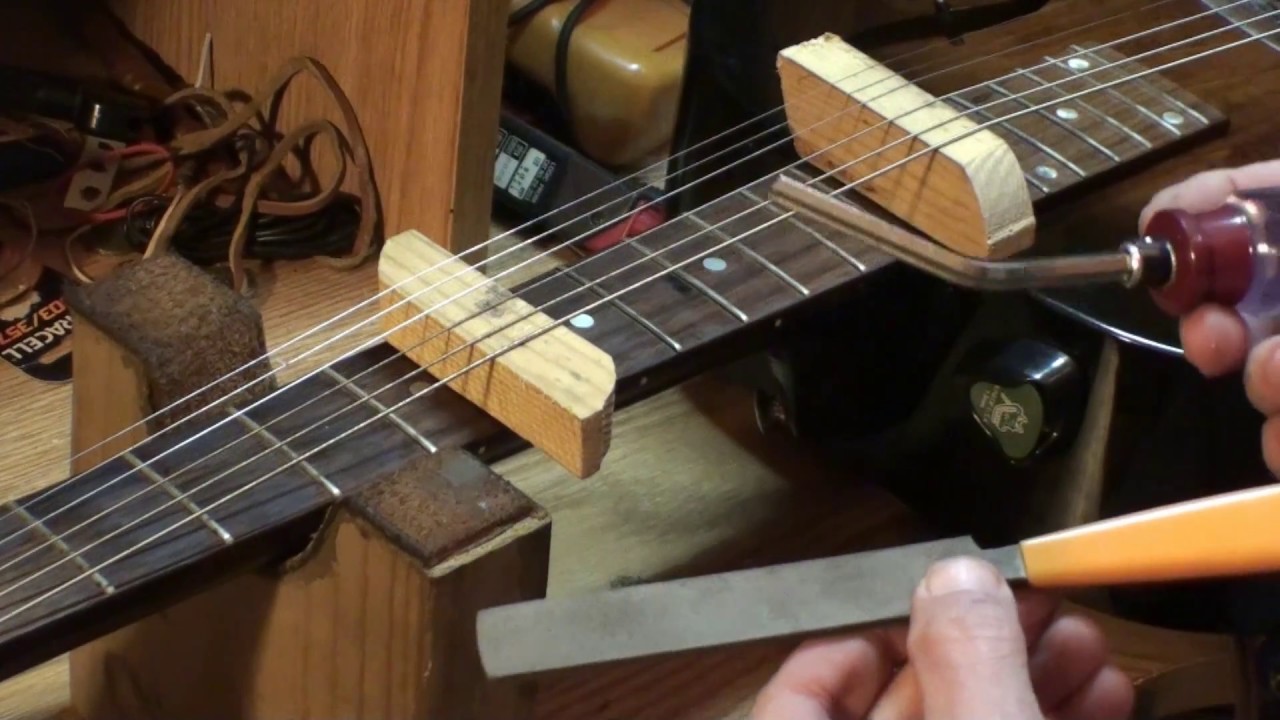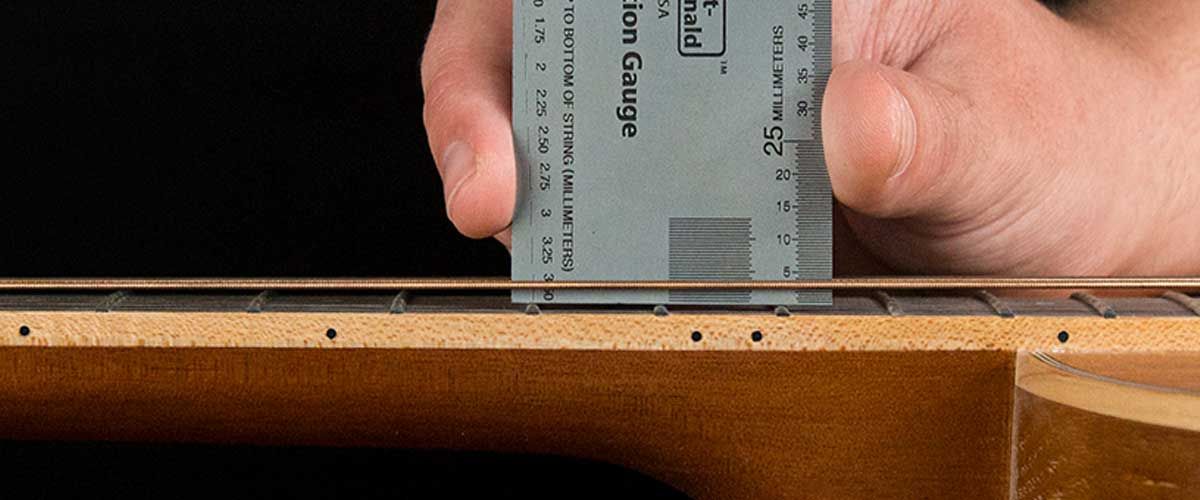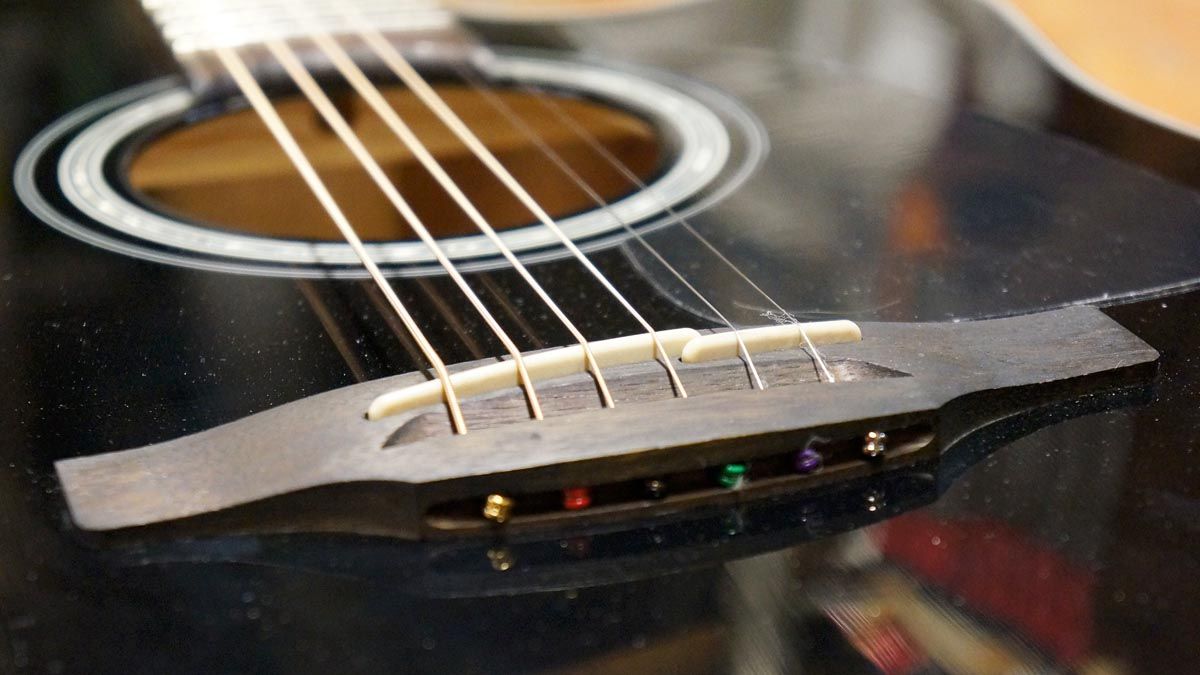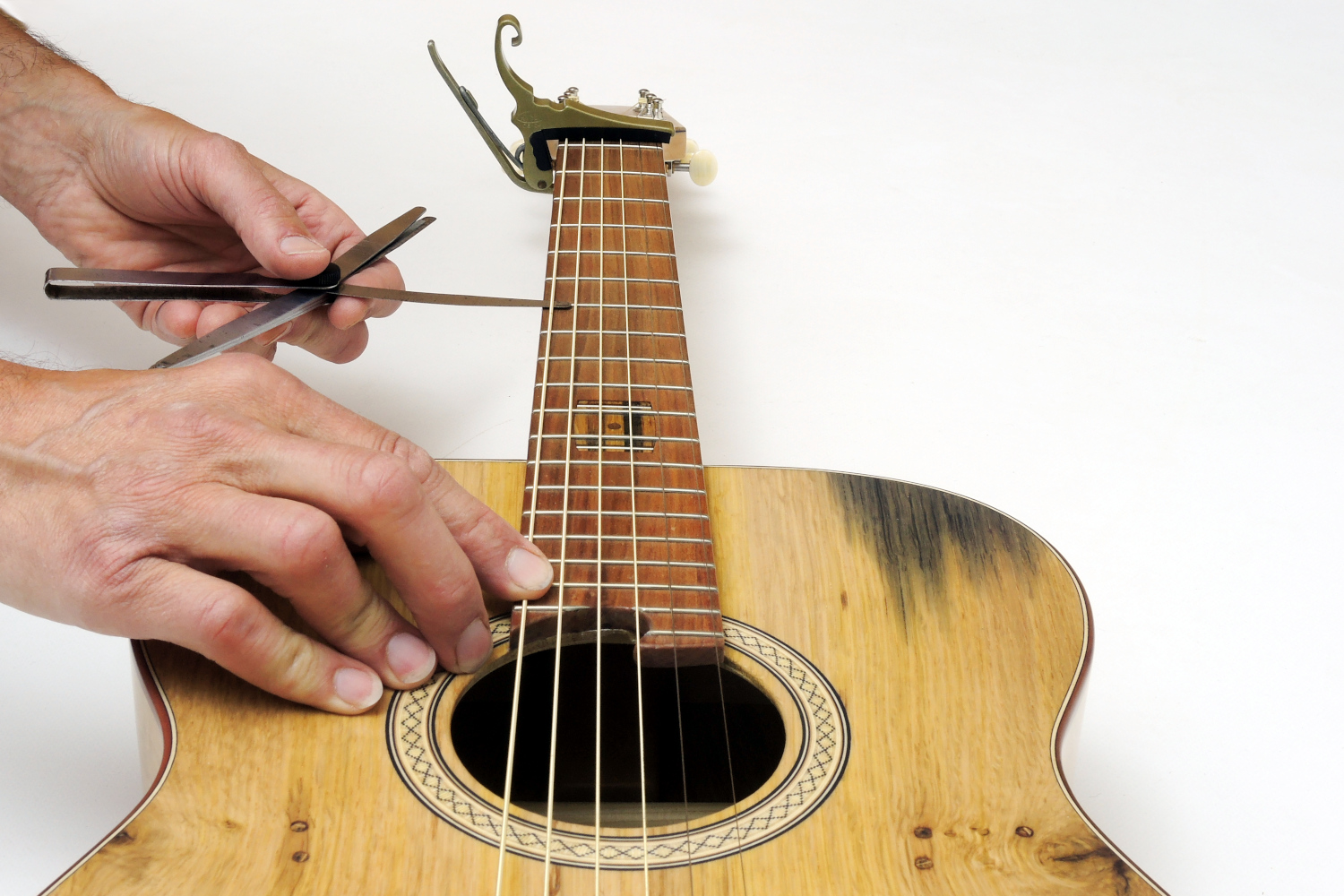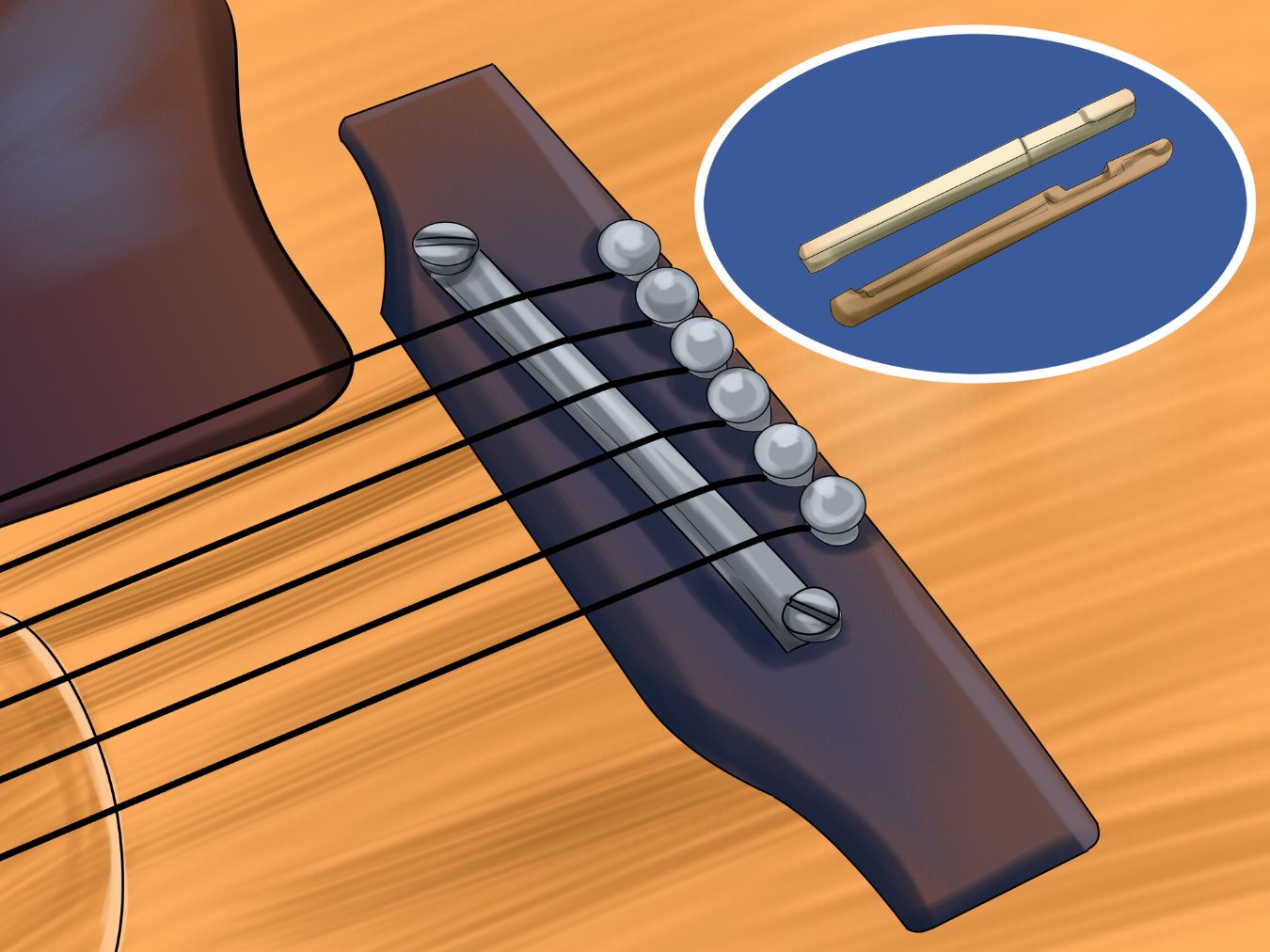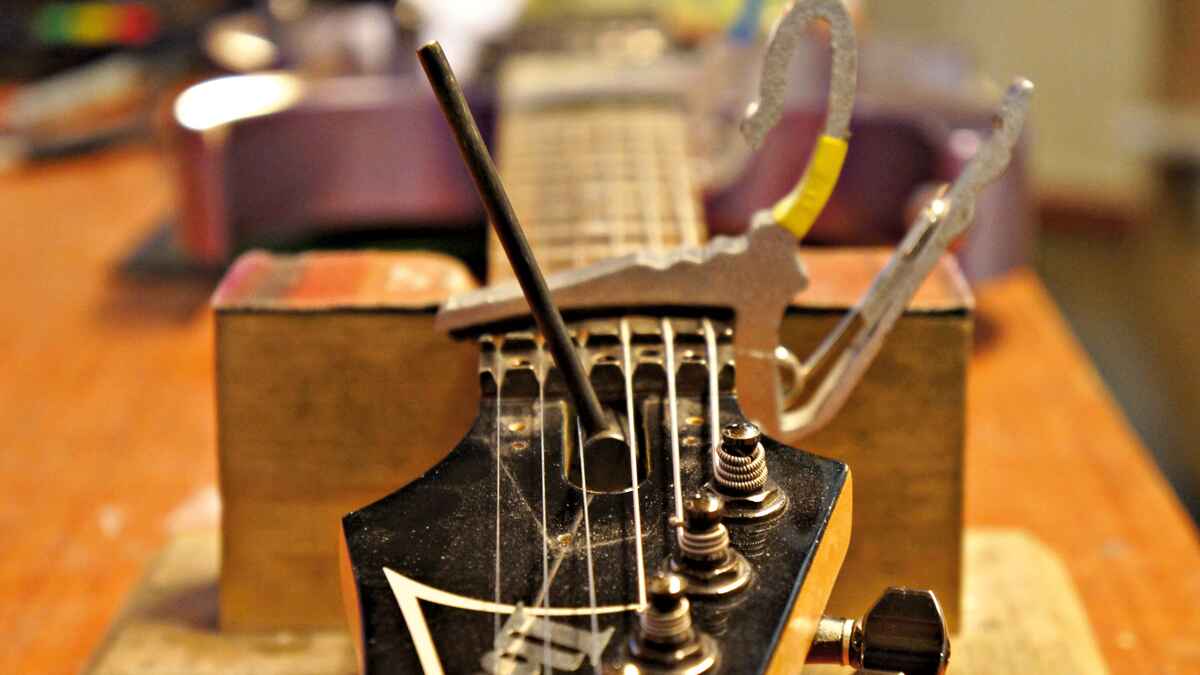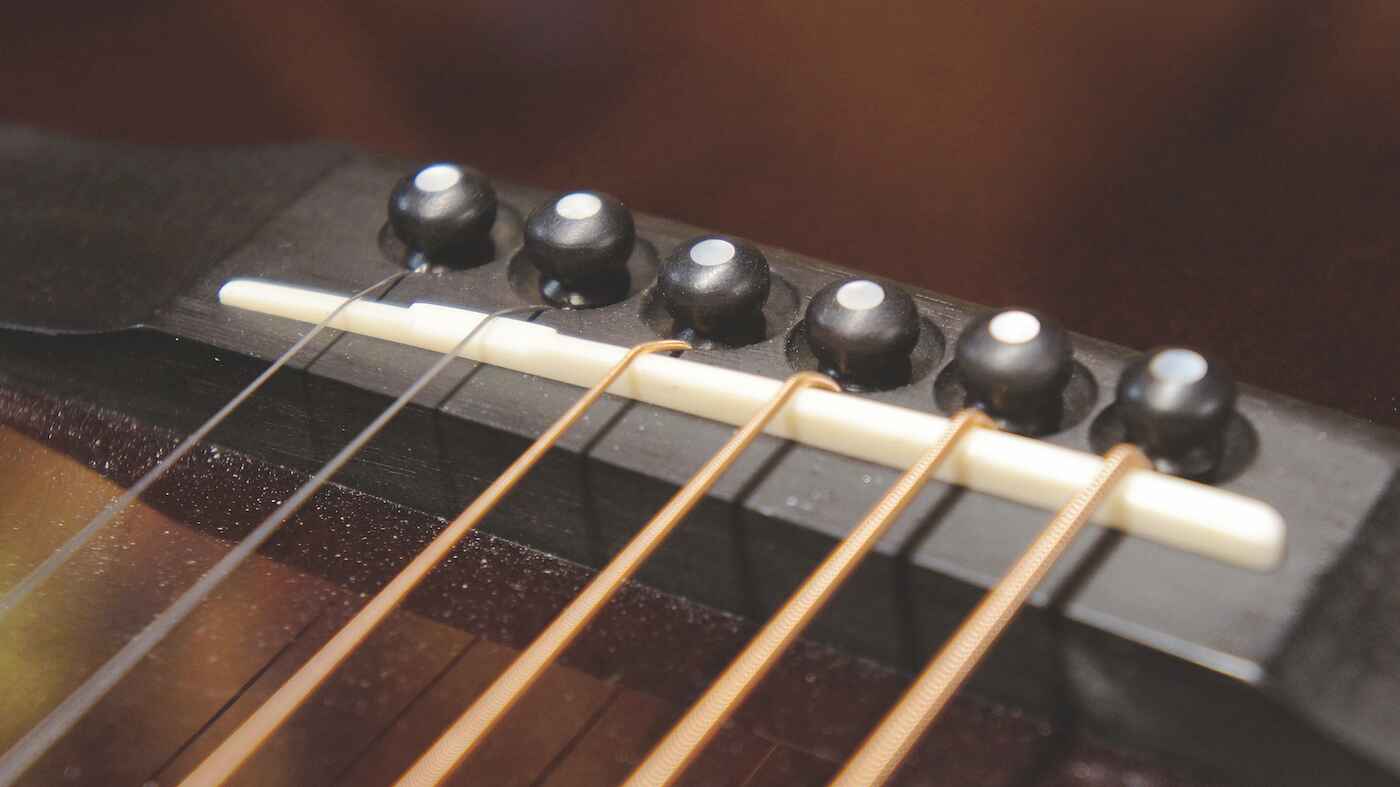Reasons for Acoustic Guitar Buzz
Acoustic guitars buzzing can be frustrating and affect the overall quality of your playing experience. There are several factors that can contribute to this issue. Understanding these reasons can help you identify and resolve the buzzing problem. Here are the most common causes of acoustic guitar buzz:
- Poor Setup: One of the main reasons for buzzing is a poorly set up guitar. If the action of the strings is too low or the neck is not properly adjusted, it can cause unwanted vibrations and buzzing sounds.
- Loose or Worn-Out Parts: Over time, the components of your guitar, such as the tuners, screws, and bridge pins, may become loose or worn-out. This can lead to buzzing or rattling noises when you play.
- Fret Buzz: Fret buzz occurs when the strings vibrate against the frets due to improper neck relief or uneven frets. This can cause buzzing sounds, especially when playing certain notes or chords.
- Action Issues: If the action, which is the distance between the strings and the fretboard, is too low, it can cause the strings to buzz against the frets. Conversely, if the action is too high, it can make the guitar more difficult to play and produce buzzing when pressing down on the strings.
- Truss Rod Problems: The truss rod is responsible for adjusting the curvature of the neck. If the truss rod is too loose or too tight, it can affect the overall playability of the guitar and create buzzing sounds.
- Bridge Issues: A loose or improperly fitted bridge can cause the strings to vibrate against it, resulting in buzzing sounds. It’s important to ensure that the bridge is securely attached to the body of the guitar.
- Nut Problems: The nut, which is the small piece at the top of the fretboard, helps hold the strings in place. If the nut slots are not properly cut or there is debris in them, it can cause the strings to vibrate unevenly and produce buzzing noises.
- String Issues: Worn-out or damaged strings can also contribute to guitar buzzing. As strings age, they can develop flat spots or become corroded, affecting their ability to vibrate properly and produce a clear tone.
- Environmental Factors: Changes in temperature and humidity can cause the wood of the guitar to expand or contract, leading to buzzing sounds. It’s essential to store and maintain your guitar in a stable environment.
- Aging or Damage: Over time, guitars can experience wear and tear, including cracks or warping, which can result in buzzing. If you suspect damage to your guitar, it’s best to have it inspected and repaired by a professional luthier.
By addressing these potential causes of acoustic guitar buzz, you can improve the playability and sound quality of your instrument. If you’re unsure about how to resolve the buzzing issue, it’s advisable to consult with a guitar technician or luthier who can offer expert guidance and perform any necessary adjustments or repairs.
Introduction
When playing the acoustic guitar, there’s nothing more annoying than the buzzing sound that can unexpectedly creep into your music. It can disrupt your rhythm, affect your confidence, and ruin the overall enjoyment of playing. But why does your acoustic guitar buzz?
Acoustic guitar buzzing can result from a variety of factors, ranging from structural issues to environmental conditions. Understanding the reasons behind this unwanted noise is crucial in order to address and resolve the problem.
In this article, we will explore the most common causes of acoustic guitar buzz and provide insights on how to rectify them. By identifying the source of the buzzing, you can take the necessary steps to ensure your guitar performs optimally and delivers the beautiful, resonant tones that it’s meant to.
So, whether you’re a beginner or an experienced player, read on to discover the possible reasons behind your acoustic guitar buzz and learn how to eliminate it for good.
It’s important to note that while some issues can be resolved with simple adjustments, others may require the expertise of a guitar technician or luthier. If you’re unsure about tackling the problem yourself, it’s always best to seek professional assistance to avoid causing further damage to your instrument.
Now, let’s dive into the main reasons why your acoustic guitar might be buzzing and explore the solutions to get your instrument buzzing-free and ready to produce pristine tones.
#1: Poor Setup
A poor setup is one of the most common reasons for acoustic guitar buzz. This refers to the overall configuration and adjustment of your instrument, including the action of the strings and the curvature of the neck.
If the action of your strings is set too low, meaning they are very close to the fretboard, the vibrating strings can come into contact with the frets, causing buzzing sounds. On the other hand, if the action is too high, it can make it harder to press down on the strings, affecting your playing and potentially leading to buzzing.
The neck relief, which is the slight curvature of the neck, also plays a significant role in guitar setup. If the neck relief is not properly adjusted, either too concave or convex, it can result in unwanted buzzes when certain notes or chords are played.
So, how can you address a poor setup? First, check the action of your guitar. You can do this by observing the gap between the strings and the frets. If it’s too low, you may need to adjust the saddle height or the truss rod. If it’s too high, you can lower the saddle or adjust the truss rod accordingly. If you’re not confident in making these adjustments yourself, it’s recommended to consult a professional guitar technician or luthier.
Additionally, evaluating the neck relief is crucial. You can check this by pressing down the first and last frets simultaneously and observing the gap between the frets and the strings around the middle frets. If there’s a significant gap or the strings are touching the frets, the neck relief may need adjustment. This can be done by tightening or loosening the truss rod as needed.
An acoustic guitar with a proper setup will have the strings at an appropriate height, allowing them to vibrate freely without making contact with the frets. By addressing any issues with the setup, you can eliminate the buzzing caused by poor string action or improper neck relief, resulting in a more enjoyable playing experience.
#2: Loose or Worn-Out Parts
Another common cause of acoustic guitar buzz is loose or worn-out parts. Over time, the components of your guitar can become loose or damaged, resulting in buzzing or rattling noises when you play.
One of the main culprits is the tuning pegs or tuners. If these are not securely tightened, they can vibrate and produce an unwanted buzzing sound. Inspect each tuner and ensure they are firmly in place. Tighten any loose screws or nuts as necessary.
Similarly, the bridge pins can also become loose or worn over time. These small pins hold the strings in place at the bridge and can cause buzzing if they are not snugly fitted. Check the bridge pins and press them down to ensure a secure fit. If any are loose, gently remove and replace them to eliminate the buzzing.
Aside from the tuners and bridge pins, other parts of the guitar can contribute to buzzing as well. Pay attention to the screws and fasteners around the pickguard, back panel, and other hardware. Ensure all screws are tightened and secure. If any are damaged or missing, replace them to prevent any buzzing noises.
In addition, check the strap buttons and output jack. If these are loose, they can vibrate against the body of the guitar, causing buzzing. Tighten or replace them if necessary to eliminate the buzzing sound.
Lastly, the frets themselves can wear down over time. This can cause buzzing when the strings come into contact with uneven or worn frets. If you suspect this is the issue, it’s best to take your guitar to a professional luthier who can evaluate and potentially level or replace the frets as needed.
Regularly inspecting and maintaining your guitar’s components is key to preventing buzzing caused by loose or worn-out parts. A simple tightening or replacement of these components can often resolve the issue and restore the clarity and resonance of your acoustic guitar.
#3: Fret Buzz
Fret buzz is a buzzing sound that occurs when the strings of your acoustic guitar vibrate against the frets, resulting in an unwanted noise. This issue is commonly caused by a few different factors, including improper neck relief, uneven or worn frets, or a combination of both.
One of the main contributors to fret buzz is incorrect neck relief. Neck relief refers to the slight curvature of the neck, which affects the height of the strings above the frets. If the neck relief is too flat or too concave, the strings may come into contact with the frets, leading to buzzing when played.
To check for neck relief, press down the first and last frets of the guitar simultaneously, then observe the gap between the middle frets and the strings. If there is too much gap or if the strings are touching the frets, you may need to adjust the truss rod. Tightening the truss rod slightly can increase the amount of relief in the neck, while loosening it can decrease the relief.
Uneven or worn frets can also contribute to fret buzz. Over time, the frets can become worn down or develop uneven surfaces due to regular playing or improper maintenance. This can result in buzzing when certain notes or chords are played. In such cases, a professional luthier may need to level, dress, or replace the frets to eliminate the buzzing.
If you’re experiencing fret buzz, it’s important to note that adjusting the truss rod or working on the frets requires careful consideration and potentially professional expertise. Attempting these adjustments without proper knowledge and tools can cause further damage to your guitar. It’s advisable to consult with a guitar technician or luthier who can properly diagnose the issue and perform the necessary repairs.
Furthermore, it’s worth mentioning that fret buzz can also be caused by other factors, such as string gauge or technique. Lighter gauge strings and heavy-handed playing can increase the likelihood of fret buzz. Experimenting with different string gauges and adjusting your playing technique may also help reduce or eliminate buzzing.
Identifying the cause of fret buzz and addressing it promptly will result in a more enjoyable playing experience with clear and resonant tones. Whether it’s adjusting the neck relief, working on the frets, or making changes to your setup, taking the necessary steps to eliminate fret buzz will enhance the sound quality and playability of your acoustic guitar.
#4: Action Issues
Action refers to the height of the strings above the fretboard. When it comes to acoustic guitar buzz, action issues can be a common culprit. If the action is too low, meaning the strings are very close to the frets, they can vibrate against the frets and produce buzzing sounds.
On the other hand, if the action is too high, it can make it difficult to press down on the strings, affecting your playing and potentially leading to buzzing when pressing down on certain frets.
There are a few factors that can contribute to action issues on your acoustic guitar. One is the positioning of the saddle at the bridge. If the saddle is too low, it can cause the strings to come into contact with the frets. Conversely, if the saddle is too high, it can make the action too high and result in buzzing when playing.
To address action issues, you can start by checking the saddle height. Remove the strings and carefully examine the saddle. If it’s too low, you can add shims or replace it with a new one that provides the desired action height. If it’s too high, you can sand down the bottom of the saddle to lower it until the desired action is achieved.
It’s important to make small adjustments at a time and restring the guitar to evaluate the action after each adjustment. This ensures that you don’t go too low or too high with the action, maintaining a balance between playability and buzzing prevention.
If adjusting the saddle doesn’t resolve the action issues, it may be necessary to evaluate the nut height as well. The nut, which sits at the top of the fretboard, helps hold the strings in place and determines the starting point for string action. If the nut slots are cut too low, it can contribute to buzzing. Similarly, if they are cut too high, it can make the action too high and affect playability.
If you suspect the nut is causing the action issues, it’s best to consult with a professional guitar technician or luthier. They can carefully evaluate and potentially adjust or replace the nut to ensure proper string height and eliminate buzzing.
By addressing action issues on your acoustic guitar, you can achieve a comfortable and playable instrument while reducing or eliminating buzzing caused by strings coming into contact with the frets. Finding the ideal balance between action and playability is key in creating an enjoyable and buzz-free playing experience.
#5: Truss Rod Problems
The truss rod in your acoustic guitar plays a vital role in maintaining the proper curvature of the neck. It is responsible for counteracting the tension exerted by the strings and helps keep the neck straight. However, problems with the truss rod can contribute to buzzing issues.
If the truss rod is too loose, the neck may have too much relief, creating a concave shape. This can cause the strings to vibrate against the frets, resulting in buzzing sounds. On the other hand, if the truss rod is too tight, it can cause the neck to have too little relief or even become back-bowed. This can also lead to buzzing due to the strings being too close to the frets.
Before attempting to adjust the truss rod yourself, it’s important to note that improper adjustments can cause irreparable damage to your guitar. If you’re unsure or uncomfortable with the process, it’s best to seek professional assistance from a guitar technician or luthier.
To assess truss rod problems, start by visually inspecting the neck. Look down the length of the neck from the headstock to the body and check for any visible signs of bowing or back-bowing. If you notice any abnormal curvature, it may indicate a truss rod issue.
To make adjustments, locate the truss rod adjustment point on your guitar. This is typically found at the base of the neck near the headstock. Using the appropriate tool, such as an Allen wrench, gently turn the truss rod in the direction needed to correct the issue. Remember to make small adjustments at a time and allow the wood to settle before reevaluating the neck’s relief.
It’s essential to proceed with caution when adjusting the truss rod. Make quarter or half turns at a time and check the neck relief frequently to ensure you’re not overcorrecting or causing damage. If you’re unsure about the correct direction or how much to adjust, it’s best to consult a professional to avoid any mishaps.
Keep in mind that truss rod adjustments should not be the first step in troubleshooting buzzing issues. It’s important to consider other potential causes, such as poor setup or uneven frets, before making truss rod adjustments. If you’re uncertain about the source of the buzzing or uncomfortable with adjusting the truss rod yourself, it’s recommended to seek the assistance of a professional for accurate diagnosis and proper adjustment.
By addressing truss rod problems and ensuring the correct neck relief, you can help eliminate buzzing on your acoustic guitar and maintain a comfortable and playable instrument for years to come.
#6: Bridge Issues
The bridge of an acoustic guitar is a critical component that plays a significant role in transmitting the vibrations from the strings to the soundboard. However, issues with the bridge can lead to unwanted buzzing sounds.
One common bridge issue that can cause buzzing is a loose or improperly fitted bridge. Over time, the bridge may become loose due to the tension of the strings or improper installation. When the bridge is loose, it can vibrate against the body of the guitar, resulting in buzzing noises. To address this problem, it’s important to ensure that the bridge is securely attached to the top of the guitar. If you suspect a loose bridge, it’s advisable to have it professionally reattached or tightened to eliminate the buzzing.
An improperly shaped or uneven bridge can also contribute to buzzing. The saddle, which sits in the bridge, determines the height and position of the strings. If the saddle is not correctly shaped or has uneven surfaces, it can cause the strings to vibrate against the saddle, leading to buzzing. In such cases, having a professional luthier reshape or replace the saddle can often resolve the issue.
In some cases, the bridge pins, which hold the strings in place at the bridge, can also cause buzzing if they are loose or damaged. Inspect the bridge pins and press them down to ensure a secure fit. If any are loose, gently remove and replace them to eliminate the buzzing.
Furthermore, the bridge may suffer from wear and tear over time. The contact point between the strings and the bridge can become worn or uneven, causing vibrations that result in buzzing. Regularly inspecting and maintaining your guitar’s bridge can help prevent this issue. If you notice signs of wear or unevenness, it’s advisable to have a professional evaluate and potentially repair or replace the bridge as needed.
Lastly, if you’ve recently changed the strings on your acoustic guitar and started experiencing buzzing, it’s possible that the strings are not properly seated in the bridge or the string slots. Ensure that the strings are securely inserted through the bridge and properly aligned with the bridge pins. Additionally, check the string slots on the bridge to make sure they are free from debris or any sharp edges that may cause buzzing.
By addressing bridge issues and ensuring a properly fitted and maintained bridge, you can eliminate buzzing caused by loose components or improper string contact. If you’re unsure about how to resolve any bridge-related problems, it’s best to consult with a professional guitar technician or luthier who can provide expert guidance and perform any necessary repairs.
#7: Nut Problems
The nut of an acoustic guitar may seem like a small and insignificant part, but it plays a crucial role in maintaining proper string height, spacing, and alignment. However, nut problems can contribute to buzzing issues on your guitar.
One common nut problem is improperly cut nut slots. Nut slots are meant to hold the strings at the appropriate height and spacing, allowing them to vibrate freely without touching the frets. If the nut slots are cut too low, the strings can contact the first few frets and produce buzzing sounds. On the other hand, if the nut slots are too high, the strings may be elevated too far from the frets, causing difficulty in pressing down on the strings and resulting in buzzing.
To address nut problems, it’s advisable to consult a professional guitar technician or luthier. They have the expertise and specialized tools to properly evaluate and adjust the nut slots. They can either file the slots to the correct depth or replace the nut entirely if needed.
Nut slippage can also cause buzzing. Over time, the tension of the strings can cause the nut to shift or become loose, leading to buzzing sounds. If you notice the nut shifting or if you experience increased buzzing, it’s important to have it secured or replaced by a professional. They can ensure a proper fit and prevent any movement that may cause buzzing.
Debris in the nut slots can also affect the string vibrations and result in buzzing. Dust, dirt, or buildup can lodge itself in the slots, preventing the strings from properly seating and vibrating. Cleaning the nut slots with a soft brush and ensuring they are free from any debris can help eliminate buzzing caused by this issue.
It’s important to note that nut adjustments and repairs require careful attention and precision. Attempting to file or adjust the nut yourself without the proper tools and knowledge can lead to irreversible damage. It’s best to seek professional assistance to ensure the nut is properly evaluated, adjusted, or replaced for optimal performance and to eliminate any buzzing problems.
By addressing nut problems and ensuring the correct string height and spacing, you can eliminate buzzing caused by improper nut slots or slippage. Seeking the help of a professional will help preserve the integrity of your guitar and maintain its playability.
#8: String Issues
The strings of an acoustic guitar are crucial for producing clear and resonant tones. However, worn-out or damaged strings can contribute to buzzing problems on your instrument.
Over time, strings can become worn and develop flat spots or corrosion, which can interfere with their ability to vibrate properly. This can lead to buzzing sounds when playing. If you notice buzzing and suspect string issues, it’s best to replace them with a fresh set of high-quality strings.
When selecting strings, consider the gauge and material. Lighter gauge strings may be more prone to buzzing, as they exert less tension on the guitar neck. Experimenting with different string gauges can help find the optimal balance between playability and buzzing prevention.
In addition to wear and tear, how you install the strings can also affect buzzing. Improper winding or not securing the strings tightly enough to the tuning posts can cause buzzing at the headstock. Make sure to wind the strings neatly and firmly around the posts to ensure proper tension and minimize buzzing.
Uneven string height can also contribute to buzzing issues. If the action of the strings is too low at certain frets, they can inadvertently come into contact with the frets and cause buzzing. In such cases, adjusting the saddle height or the truss rod can help raise the action and eliminate the buzzing. It’s important to note that making adjustments to the action should be done with caution or by seeking professional assistance.
Furthermore, be mindful of how you tune your guitar. Stretching the strings properly during the initial tuning process and ensuring that each string is in tune can minimize the chances of buzzing caused by loose or improperly tensioned strings.
Regular maintenance and care for your guitar strings are crucial to prevent buzzing and optimize the sound quality of your instrument. Wipe down the strings after each use to remove oils, dirt, and sweat that can accumulate and affect their performance. Additionally, periodic string changes will help maintain a fresh and vibrant tone.
By addressing string issues and maintaining proper care, you can prevent and eliminate buzzing caused by worn, improperly tensioned, or damaged strings. Regular string changes and attention to string installation will contribute to a more enjoyable playing experience and ensure the best sound possible from your acoustic guitar.
#9: Environmental Factors
Environmental factors can have a significant impact on the playability and performance of your acoustic guitar. Changes in temperature, humidity, and other environmental conditions can cause the wood of the guitar to expand or contract, leading to buzzing sounds.
One of the main environmental factors to consider is humidity. Too much or too little humidity can affect the moisture content of the wood, causing it to swell or shrink. In humid conditions, the wood can absorb moisture, leading to swelling and potential changes in the neck relief or the action of the strings. Conversely, in dry conditions, the wood can lose moisture, causing it to shrink and potentially create buzzing due to lower string action.
To minimize the effects of humidity on your guitar, it’s important to store and maintain it in a controlled environment. Using a humidifier or dehumidifier, depending on the climate, can help regulate the humidity level to ensure it remains within a safe range. Keeping your guitar in a sturdy case with humidity control features can also provide additional protection.
In addition to humidity, temperature fluctuations can also impact your guitar. Extreme temperatures can cause the wood to expand or contract rapidly, leading to buzzing. Avoid exposing your guitar to extreme heat or cold, and if you need to transport it in cold weather, give it ample time to acclimate to the new temperature before playing to minimize the risk of buzzing.
Moreover, sudden changes in environmental conditions can cause rapid shifts in the wood’s moisture content and affect the guitar’s playability. If you bring your guitar from a cold outdoor environment to a warm and humid room, for example, condensation can occur, leading to temporary buzzing. Allow your guitar to gradually acclimate to the new conditions before playing to minimize the impact on its performance.
It’s worth noting that while you can take precautions to control the environment around your guitar, it may not be possible to completely eliminate the effects of environmental factors. Therefore, it’s important to regularly inspect your guitar for any buzzing issues that may arise due to shifts in temperature or humidity and consult with a professional if needed.
By being aware of the environmental factors that can affect your guitar, taking appropriate measures to control humidity and temperature, and allowing your guitar to acclimate to new conditions, you can reduce the risk of buzzing caused by fluctuations in the environment. Taking good care of your acoustic guitar will ensure its longevity and optimal performance.
#10: Aging or Damage
As with any musical instrument, aging and damage can contribute to buzzing issues on an acoustic guitar. Over time, the wood, hardware, and other components of the guitar can deteriorate, leading to buzzing and other performance problems.
Wood is a natural material that can undergo changes as it ages. It may develop cracks, warps, or other structural issues, which can affect the overall playability and sound quality of the instrument. These issues can lead to buzzing as the integrity of the guitar is compromised.
If your guitar has sustained physical damage, such as from a fall or accident, it’s possible that the buzzing is a result of structural issues caused by the impact. Even minor damage to the body, neck, or bracing can cause the guitar to resonate differently, resulting in buzzing sounds. In such cases, it’s best to have the guitar inspected by a professional luthier who can assess the extent of the damage and provide appropriate repairs.
Furthermore, components such as the frets, bridge, and saddle can also wear down over time. Worn or uneven frets can cause buzzing, while a worn or improperly fitted bridge or saddle can disrupt the string vibrations and result in buzzing as well. If you suspect these components are causing the buzzing, it’s recommended to have a professional luthier evaluate and potentially repair or replace them as needed.
Aging and damage can affect not only the playability but also the tone of your guitar. As the instrument ages, the wood can mature, resulting in changes in resonance and tonal characteristics. While some players appreciate the unique qualities that aging brings to an instrument, others may find that it contributes to buzzing or other issues. In such cases, seeking professional guidance can help determine the best course of action.
Regular maintenance and care for your guitar are essential to prevent or minimize the effects of aging and damage. Proper storage, regular string changes, keeping the guitar in a stable environment, and periodic inspections by a professional can help identify and address potential issues before they worsen.
If you notice buzzing on your guitar that cannot be attributed to other causes, it’s important to consider the possibility of aging or damage. Seeking the expertise of a professional luthier can help assess the condition of your guitar and recommend appropriate repairs or adjustments to eliminate the buzzing and restore the instrument’s performance.
By addressing aging or damage-related issues promptly and properly maintaining your guitar, you can extend its lifespan and ensure that it continues to produce clear and resonant tones without the interference of buzzing.
Conclusion
Acoustic guitar buzzing can be a frustrating problem that hampers your playing experience and affects the sound quality of your instrument. However, by understanding the common causes and taking appropriate steps to address them, you can eliminate buzzing and restore the optimal performance of your guitar.
We explored ten possible reasons for acoustic guitar buzz, including poor setup, loose or worn-out parts, fret buzz, action issues, truss rod problems, bridge issues, nut problems, string issues, environmental factors, and aging or damage. Each of these factors can contribute to buzzing, and it’s important to identify the specific cause(s) affecting your guitar to implement the right solution.
From adjusting the setup and tightening loose parts to leveling frets or replacing worn-out strings, resolving acoustic guitar buzz often requires careful attention and may involve seeking professional assistance when necessary. It’s crucial to strike a balance between playability and addressing the buzzing issue to ensure the best sound quality and performance of your instrument.
Remember to regularly inspect and maintain your guitar, store it in a stable environment, and take precautions to control humidity and temperature changes. By doing so, you can prevent potential issues that may lead to buzzing. Additionally, maintaining proper string care, replacing strings regularly, and ensuring accurate tuning can help eliminate buzzing caused by string-related factors.
In some cases, buzzing may be a sign of aging or damage to your guitar. If you suspect this to be the cause, consult with a professional luthier or guitar technician for a thorough evaluation and appropriate repairs or adjustments.
Ultimately, addressing acoustic guitar buzz requires a combination of knowledge, technique, and sometimes professional assistance. By being proactive and attentive to your instrument, you can maintain a buzz-free acoustic guitar that delivers beautiful tones and enhances your playing experience for years to come.







